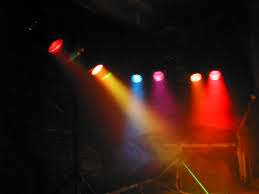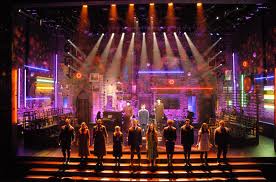 In the world of theatre speak, designers use terms, both slang and terms of art, which are specific to their art form. Today we look at a few words used in theatre speak by those involved in lighting. There’s a lot of jargon in lighting; we’re illuminating three today.
In the world of theatre speak, designers use terms, both slang and terms of art, which are specific to their art form. Today we look at a few words used in theatre speak by those involved in lighting. There’s a lot of jargon in lighting; we’re illuminating three today.
Gobo
You’re in a production meeting and the stage manager or scenic designer asks the director, “Are you going to use a real window in that scene?” and the director answers, “I thought maybe we could use a gobo?” The director then looks to the lighting designer (LD) and the designer nods. Problem solved and they move onto the next item on the agenda.
 Everyone in that room knows the theatre speak term gobo . A gobo is a pattern that is placed in front of a light source. The light source is focused somewhere on the stage area. It might be the floor or upstage on a cyclorama. When the light is illuminated it hits the gobo and the pattern is projected on the floor or upstage on the cyc. Viola, instant scenery!
Everyone in that room knows the theatre speak term gobo . A gobo is a pattern that is placed in front of a light source. The light source is focused somewhere on the stage area. It might be the floor or upstage on a cyclorama. When the light is illuminated it hits the gobo and the pattern is projected on the floor or upstage on the cyc. Viola, instant scenery!
Along with creating scenery, gobos can be used to project abstract patterns, reinforce emotional content, and set time of day, season or year. They’re pretty darn handy.
Gel
 The next theatre speak word is heard just about every day when electrics folks are around. In a production meeting, the master electrician may ask, “How much money do we have for gel?” If you don’t work in the theatre, your question may be “What is gel?”
The next theatre speak word is heard just about every day when electrics folks are around. In a production meeting, the master electrician may ask, “How much money do we have for gel?” If you don’t work in the theatre, your question may be “What is gel?”
Gel is jargon for “gelatin.” Now you’re probably wondering, “What does gelatin have to do with theatre lighting?” Okay, some of the actual terms of art used in the theatre for gel are “color medium,” “color filter,” or “color gel.”
You may have surmised by now that gels are used to adjust the color of the light in instruments. They are thin sheets of color that are placed in a gel frame and like the gobo placed in front of the source of light. But why are they called “gels?”
These color sheets used to have a gelatin base and for years they were used to alter the color of lighting instruments. But as lighting instruments grew more powerful and burned hotter, the lifespan of color filters made from gelatin grew shorter and shorter. In the 1960s and ‘70s, companies developed new types of color medium made from polyester and polycarbonate. These withstood the heat much better, lasting longer.
But theatre folks did not start asking questions about “poly?” They continued to use the term “gel.” By the way, in over 40 years in the theatre I have never heard the term “color filter” used and I have heard the phrase “color medium” used about twice. A gel is a gel and lights get “gelled.” (Yes, it is also a verb.)
Leko
 The last theatre speak word for today is “leko.” Leko is actually a shortened form of a brand name that over many years became associated with ellipsoidal reflector spotlights (ERS). (Think of it this way: you may say “Xerox this,” when you actually mean “Photocopy this.”) Here’s a little history.
The last theatre speak word for today is “leko.” Leko is actually a shortened form of a brand name that over many years became associated with ellipsoidal reflector spotlights (ERS). (Think of it this way: you may say “Xerox this,” when you actually mean “Photocopy this.”) Here’s a little history.
Leko is short for Lekolite. The Lekolite was created by the two men who founded Century Lighting, Joseph Levy and Edward Kook. Their lighting instrument, which was introduced in 1933, was extremely popular in theatre and concert venues into the 1990s. Contemporary lighting instruments are direct descendants of the Leko. The term Leko was created by using the first two letters of each man’s last name. Although the Leko was a ERS, it was not the only ERS. Like gel, you’ll still hear the term Leko used when referring to an ERS.
A Little Brighter?
Do you feel a tad brighter when it comes to lighting terms in the theatre? Now when someone asks, “What color gel to you want in that Leko and does the window gobo go in that other Leko?” you’ll know exactly what is going on. Wasn’t that shockingly easy to understand?

